In July, 1964, after a few hours of sightseeing in Berlin, along with the rest of the tour group from the Institute for the Study of the USSR, I boarded a Soviet train bound for Moscow. There were about 25 of us in all. It was a comfortable train with sleeping cars; the journey was leisurely and pleasant, with a brief stop in Warsaw, where we were able to get off the train and look around a bit. I remember seeing soldiers with AK-47s roaming the streets. Crossing the Soviet border, we went through customs at Brest-Litovsk. They made us open our suitcases and did a cursory inspection of the contents, just to make sure we weren’t bringing in any suitcase nukes or stacks of Bibles, etc., and we had to get off the train and wait while they lifted the train cars off the narrow-gauge Western-style wheel-beds and put them onto wide-gauge Russian wheel-beds. Then it was on to Moscow.
There were two ways of visiting the Soviet Union as a tourist in those days. You could go under the auspices of the official state travel agency, Intourist (a contraction of the Russian words inostrannyi turist, “foreign tourist”). This generally involved going as an individual or in a small group, with an assigned guide, car and driver, and was quite expensive, unaffordable for most. I remember reading accounts of trips with Intourist, usually written by wealthy conservatives such as William F. Buckley, who complained about lousy accommodations, tasteless food, boorish guides with garlic on their breath, annoying restrictions and dreary, cheerless tours. I never traveled with Intourist, so I can’t speak to that. The other way to go was with the “youth” travel agency, Sputnik, which handled large groups, not necessarily composed entirely of young people – ours certainly wasn’t. Sputnik was more affordable, with corresponding reductions in the level of amenities. Our group, of course, was under the auspices of Sputnik. Sputnik’s hotels, naturally, were more spartan than those of Intourist. We didn’t get to stay in any of the ritzy Intourist hotels such as the Metropol. Our lodging in Moscow was graced with the imaginative name of “Hotel Tourist”.
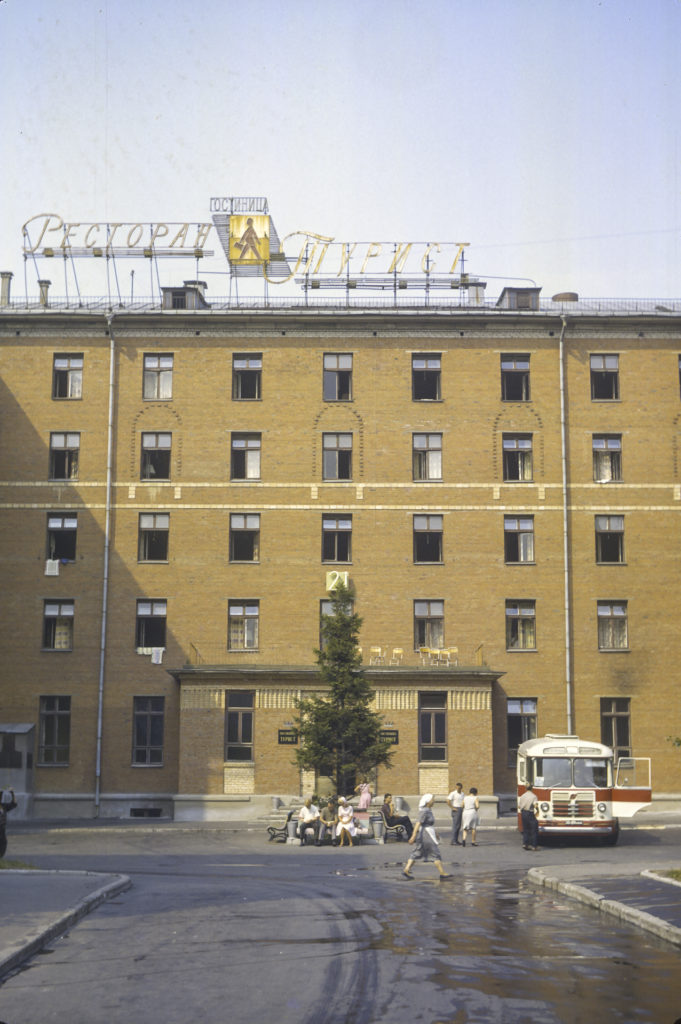
Sputnik gave us two guides, Natasha and Sasha, women in their thirties as far as I could tell. Natasha was heavy-set and relatively easygoing, at least compared to Sasha. Sasha was trim and svelte, and would have been attractive but for her stiff demeanor and severe expression. She was aggressively propagandistic and seemed to have a chip on her shoulder, always on the lookout for provocative behavior and insults against the regime. We got off on the wrong foot with them at the start. On our way to our first sightseeing stop, we passed the statue of Felix Dzherzinsky in Lyubyanka Square. Dzherzinsky was the first head of the Soviet secret police, initially known as the Cheka. Sasha pointed out the statue to Bob Barrett, our tour leader, and asked him if he knew who it was. Upon receiving the correct answer, i.e. that Dzherzinsky was the head of the Cheka, Sasha said, “Yes, a very excellent organization.” Bob replied, “Perhaps at first, but later it overfulfilled its plan.” Enraged, Sasha ordered the bus driver to stop and take us back to the hotel. After some acrimonious discussion, Sasha relented and allowed the tour to continue. Our first stop was Red Square.
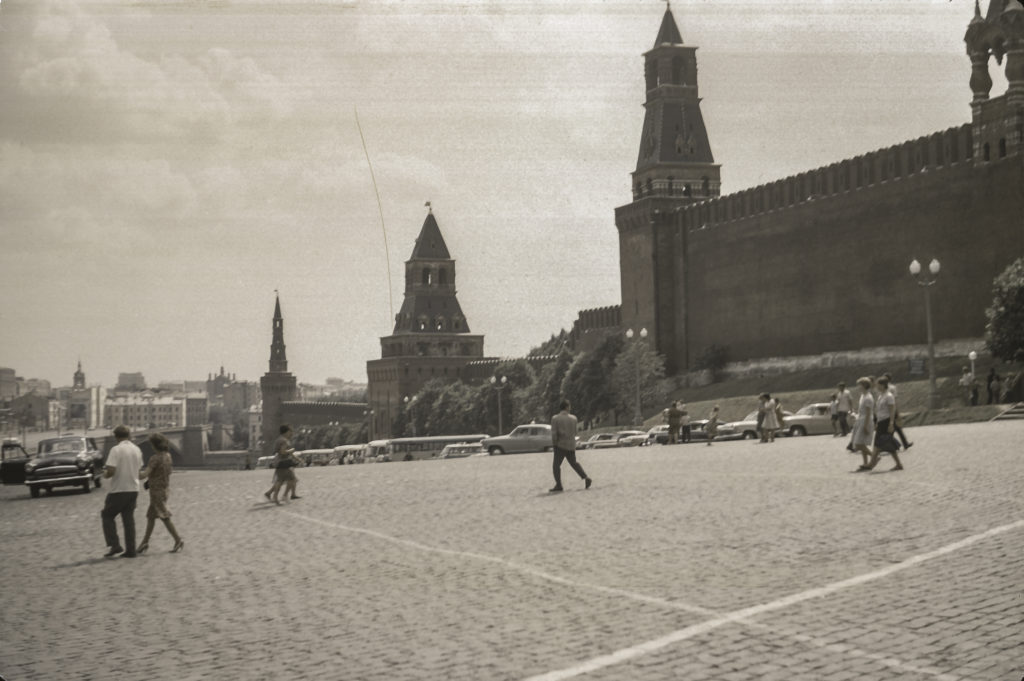
Of course it was de rigeur to visit Lenin’s Mausoleum. The length of the line waiting to get into it was appalling, but we didn’t have to stand in it. Foreign tour groups were privileged, and our guides took is right to the head of the line. I wasn’t able to take a picture inside the mausoleum, but I remember that Lenin’s head looked yellow and waxy, and I irreverently wondered whether they had substituted a wax dummy for the real thing.
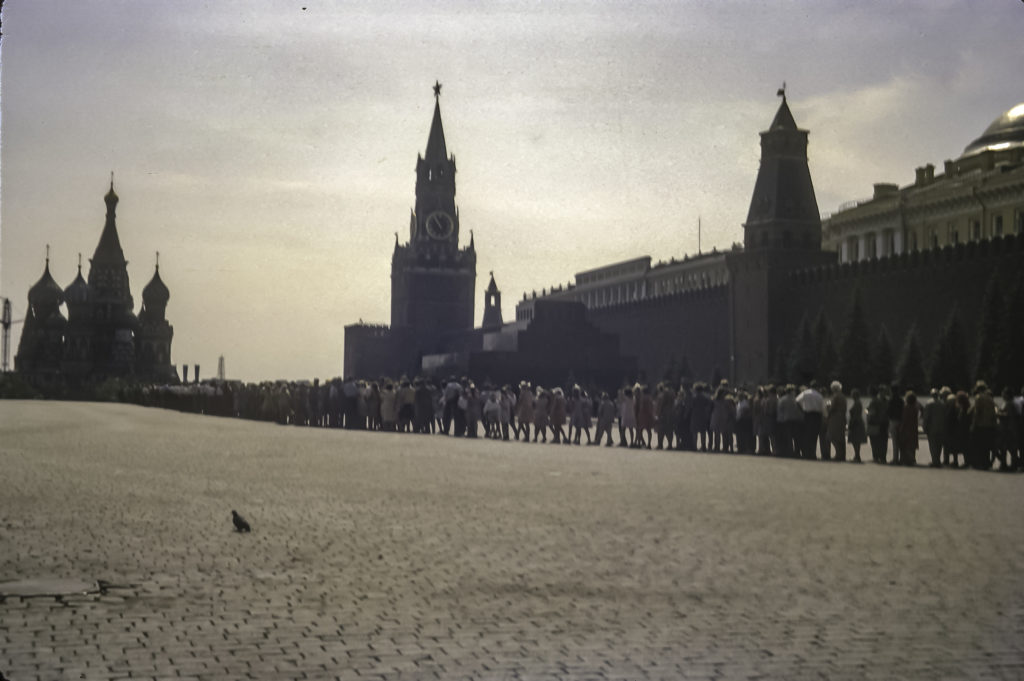
Behind the mausoleum, between it and the Kremlin wall, is a row of graves. In them are buried important Bolshevik and Soviet figures, such as Yakov Sverdlovsk, Mikhail Kalinin, Mikhail Frunze, Felix Dzherzinsky. When I visited, all of the graves except one had a pedestal with a bust of the person buried therein on top. The one grave without a pedestal or bust was the one on the end of the row – that of Josef Stalin.
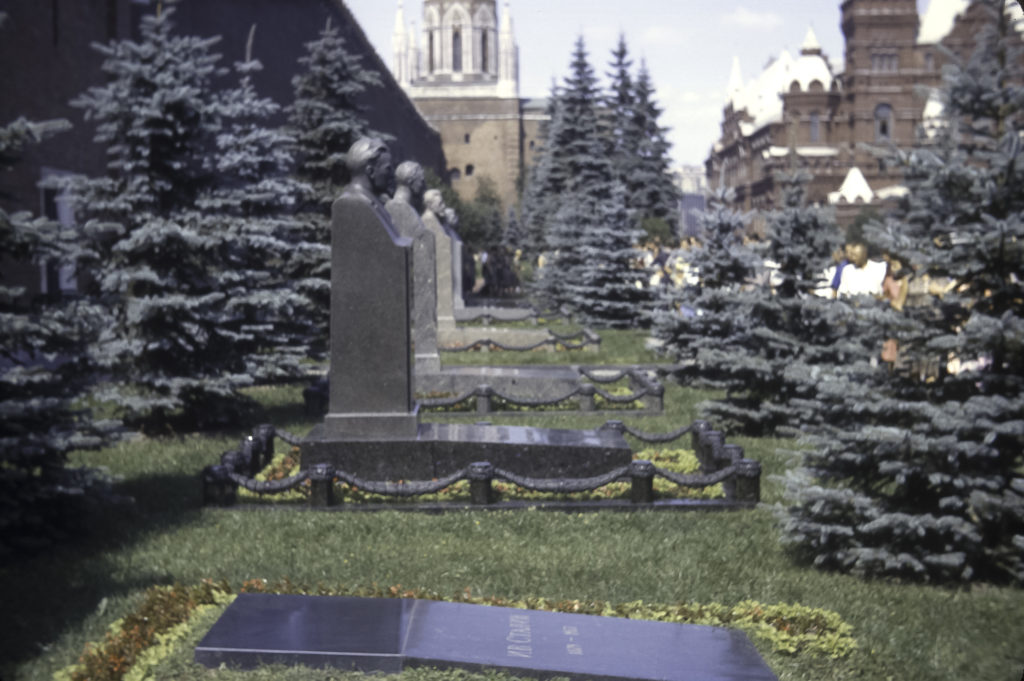
When Stalin died in 1953, his remains were placed in the Mausoleum side-by-side with Lenin’s body. But in 1961, when Nikita Khrushchev was in power, Stalin was kicked out of the Mausoleum and entombed in the grave pictured below. Some years later, in 1970, a pedestal and bust were added to Stalin’s grave.
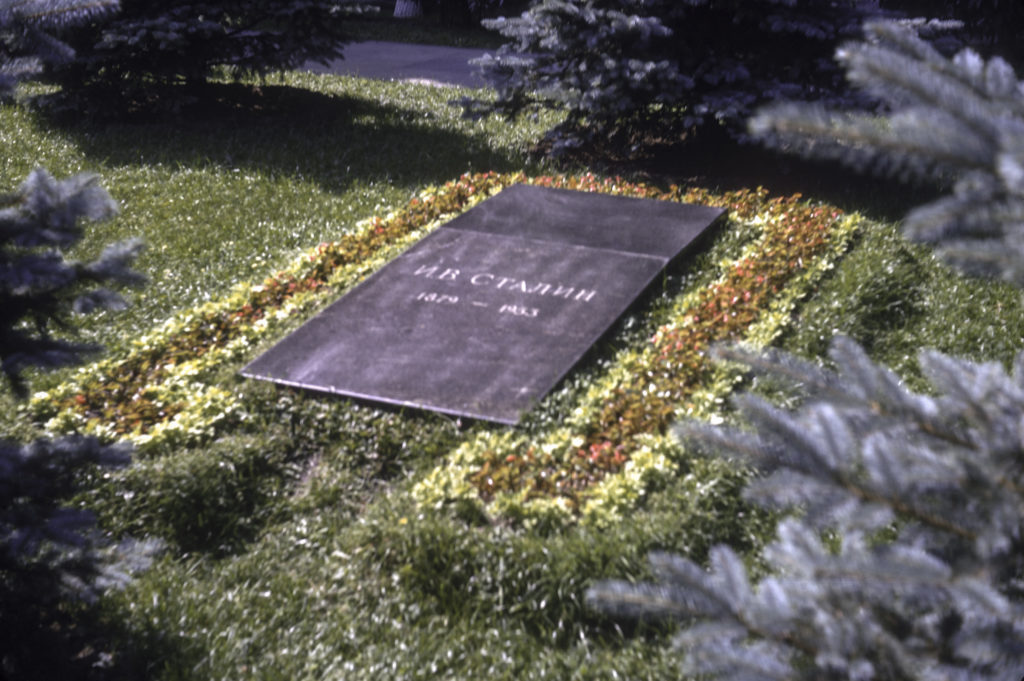
Since I visited the site, other leaders of the Soviet Union, such as Brezhnev, Andropov and Chernenko, have been added to the row of graves at the Kremlin wall. Mikhail Suslov, the hard-line party ideologue in the Brezhnev years, who died in 1982, is now buried to the left of Stalin. Behind the row of graves, in the Kremlin wall itself, there is a series of niches containing the ashes of other noted figures, including Soviet and foreign Communist leaders, cosmonauts, military men, writers, etc.
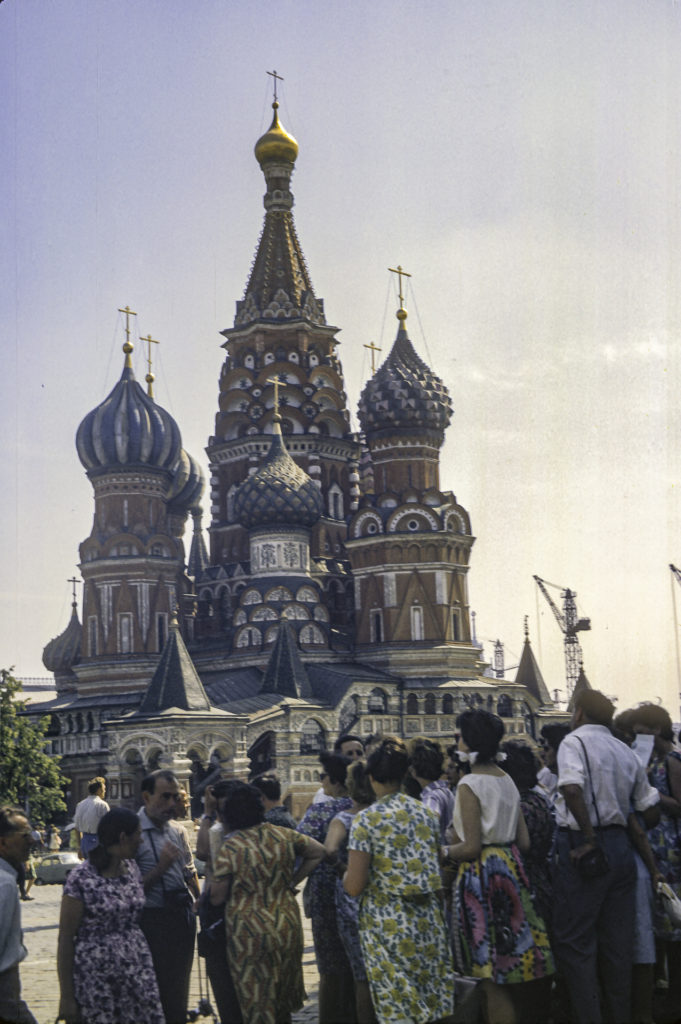
Also on Red Square next to the Kremlin is St. Basil’s Cathedral, the most widely recognized symbol of Russia. Many people mistake it for the Kremlin itself. It is not really a cathedral because it is not the seat of a bishop. St. Basil’s was built from 1555 to 1561, i.e. during the early part of the reign of Ivan the Terrible, to commemorate the conquest of the Khanate of Kazan’ in 1552. The origins of the church are shrouded in myth and legend. One of the legends has it that there were two architects, named Barma and Postnik, and that Ivan the Terrible had them blinded after the completion of the church so that they could never build anything so beautiful again. Historians tend to dismiss this story. Some believe that there was only one architect, named Postnik Yakovlev, and that he worked on later projects such as the restoration of the Cathedral of the Annunciation inside the Kremlin in the 1560s. Whatever the truth may be, St. Basil’s burned down or was badly damaged by fire restored several times over the ensuing centuries, and each time was restored with modifications, so that today’s church is somewhat different from the original. Oddly, even though Napoleon ordered the church to be blown up during his invasion in 1812, his order was not carried out and it escaped unscathed on that occasion.
There are also urban legends surrounding the treatment of St. Basil’s under Josef Stalin. One of them I heard from a friend in Moscow. He said that during the thirties, Stalin was considering urban plans that envisioned demolishing St. Basil’s, and consulted a Jewish architect (my friend was also Jewish) to ask him how this could best be done. The architect replied “Over my dead body,” to which Stalin genially replied, “That can be arranged.” Wikipedia presents a somewhat different story. The important point, however, is that St. Basil’s was spared, unlike some other priceless legacies of history, one of which I’ll deal with later in this post.
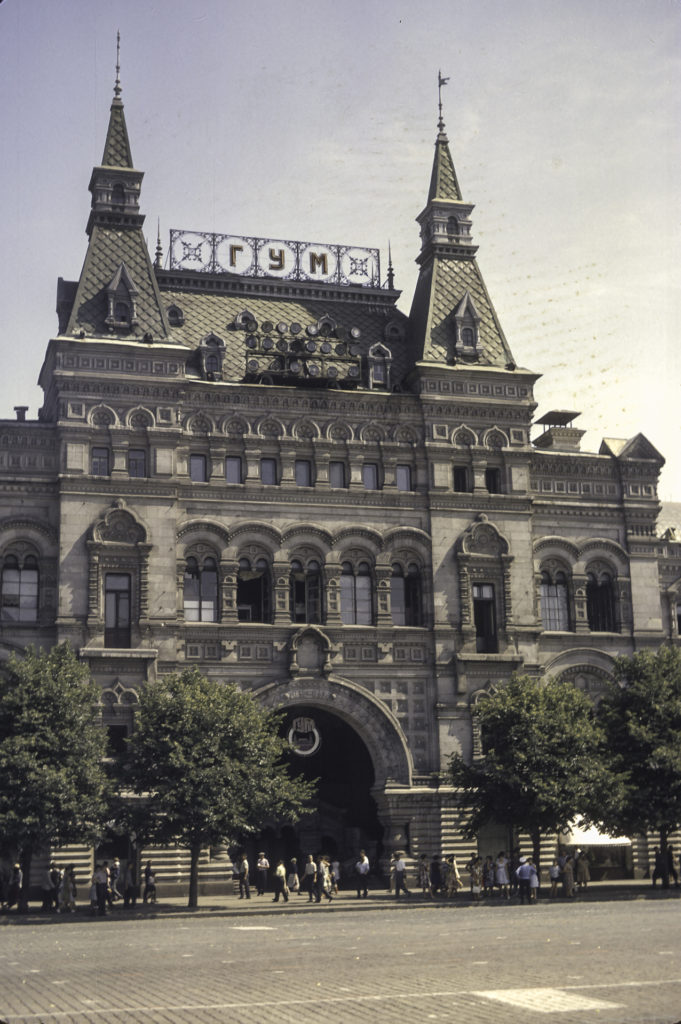
Another famous attraction on Red Square is GUM. When I was in Russia, the letters stood for Gosudarstvennyi Universalnyi Magazin (State Department Store), but that name is no longer appropriate because the building was privatized after the 1991 revolution, and they now stand for Glavnyi Universalnyi Magazin (Main Department Store). The structure was originally built in the 1890s as an indoor shopping mall known as the Upper Trading Rows. After the 1917 revolution it was confiscated by the government, and in 1928 Stalin turned it into an office building, but it again became a department store after his death. I didn’t take any photos of the interior, but Wikipedia has an article with pictures showing how it looks. The appearance is striking – it has a glass roof, three levels of shops and facades of marble, granite and limestone. The design was far in advance of its time.
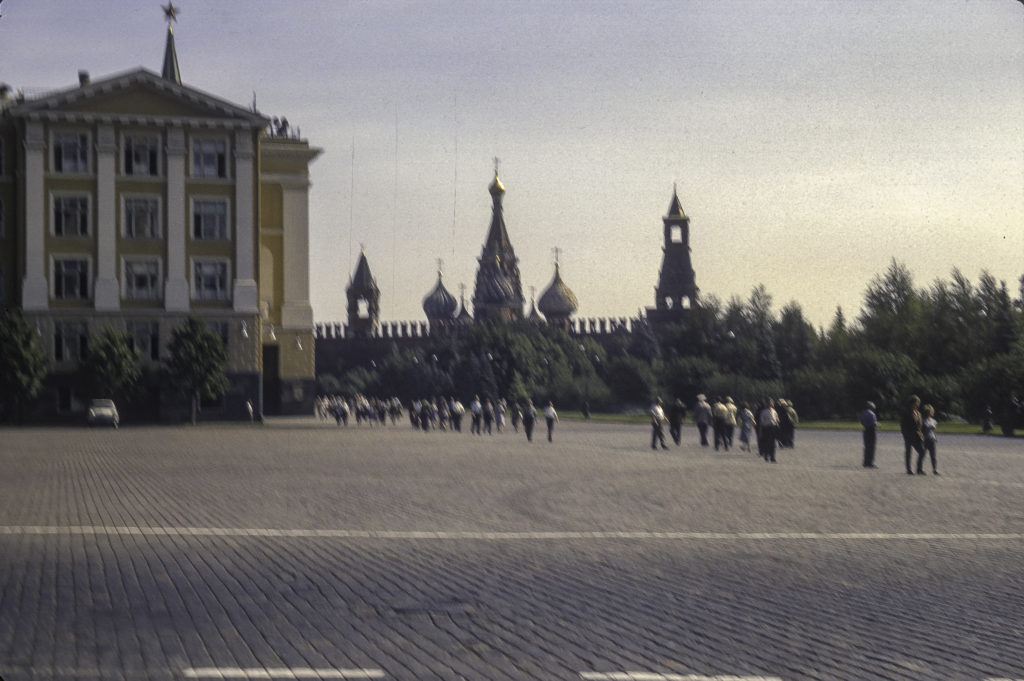
The Kremlin, a fortress within a city, has existed since the beginnings of the city of Moscow, but it was initially constructed in wood, and only began to take form in stone in the 1360s. The existing walls and towers were built by Italian architects in the reign of Vasily III from 1485 to 1495. The Kremlin was the seat of government and residence of the ruler until Peter the Great moved the capital to St. Petersburg; afterward it continued to be the residence of the Tsars when they visited Moscow. After the 1917 Revolution, the Bolsheviks moved the capital back to Moscow, and it again became the seat of government; both Lenin and Stalin had living quarters there. The Kremlin was closed to tourists until 1955, and until then the only foreigners allowed inside were official visitors.
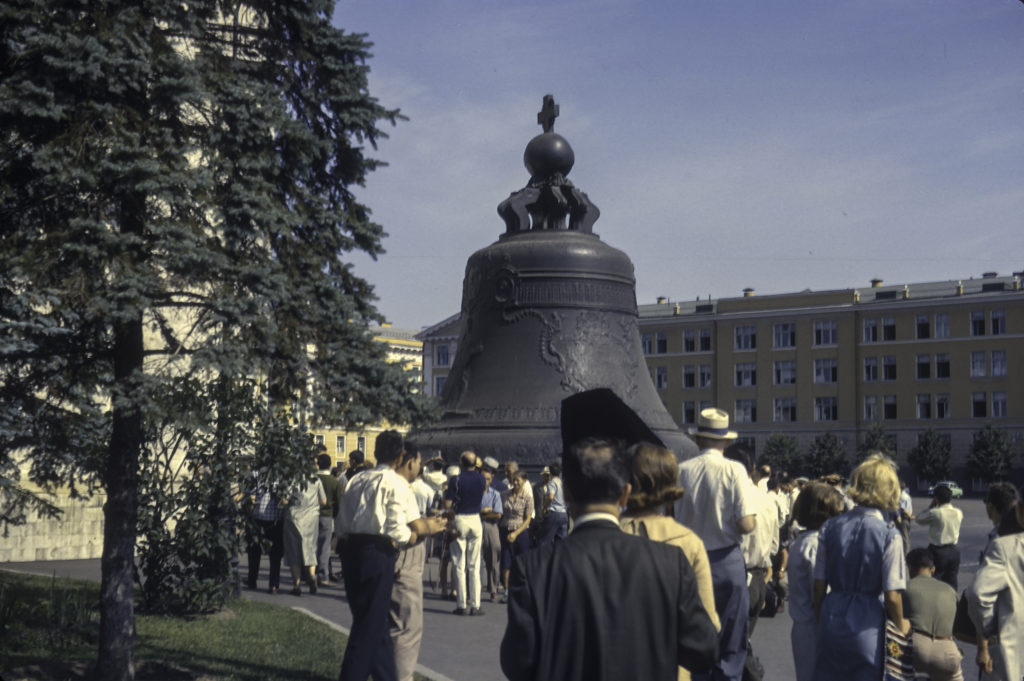
The Tsar-Bell, which stands near the Ivan the Great Bell Tower in the Kremlin, is the world’s largest bell, but it has never rung. It was cast in 1735 on the orders of Empress Anna, Peter the Great’s Niece. The casting was initially successful, but a fire which broke out in the Kremlin in 1737 resulted in a huge piece cracking off the bell. You can see the hole it left in the picture above. The piece that cracked off is displayed with the bell, but it cannot be seen in the picture above because of the crowd blocking the view – mostly members of our tour group.
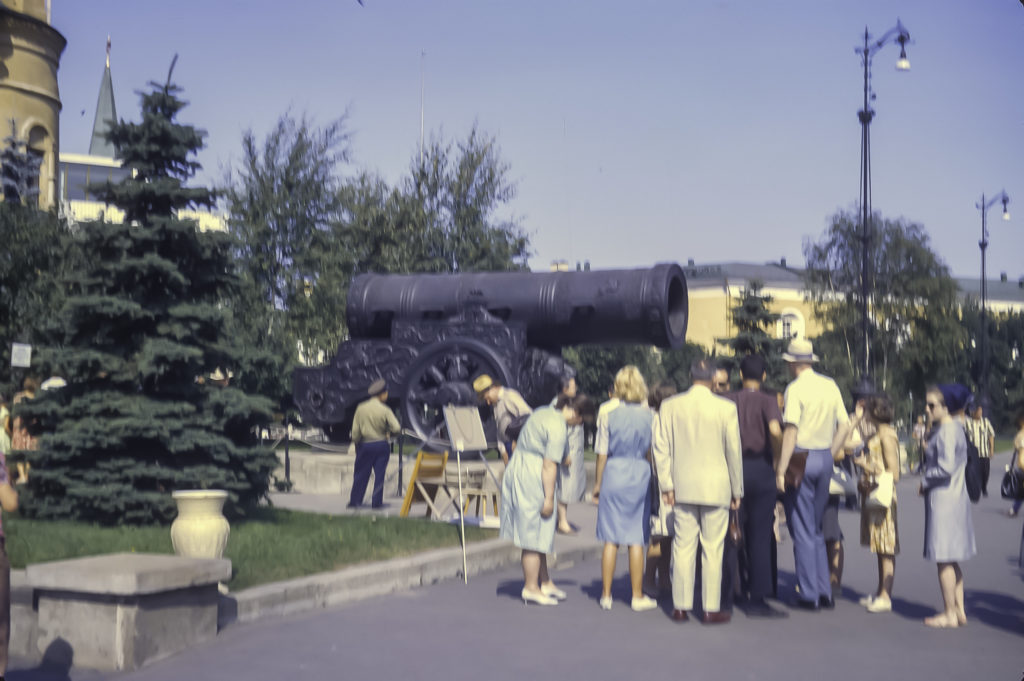
The Tsar’-Pushka, or Tsar-Cannon, which stands on Ivanovskaya Square in the Kremlin, was cast in 1586, during the reign of Ivan the Terrible’s successor Fedor Ivanovich. It is the largest cannon ever made by caliber, with a bore of 890 mm (35 inches). As far as was known when I was in the Soviet union, it had never been fired (Voltaire once said that the two most noteworthy items in the Kremlin were a bell that had never been rung and a cannon which had never been fired). However, according to Wikipedia, in 1980 experts from the Artillery Academy determined that it had been fired at least once. Even so, it was never actually used against an enemy, and its value was primarily as a propaganda tool, to frighten the tsar’s enemies. I have a scale model of it in my house, which I use as a doorstop.
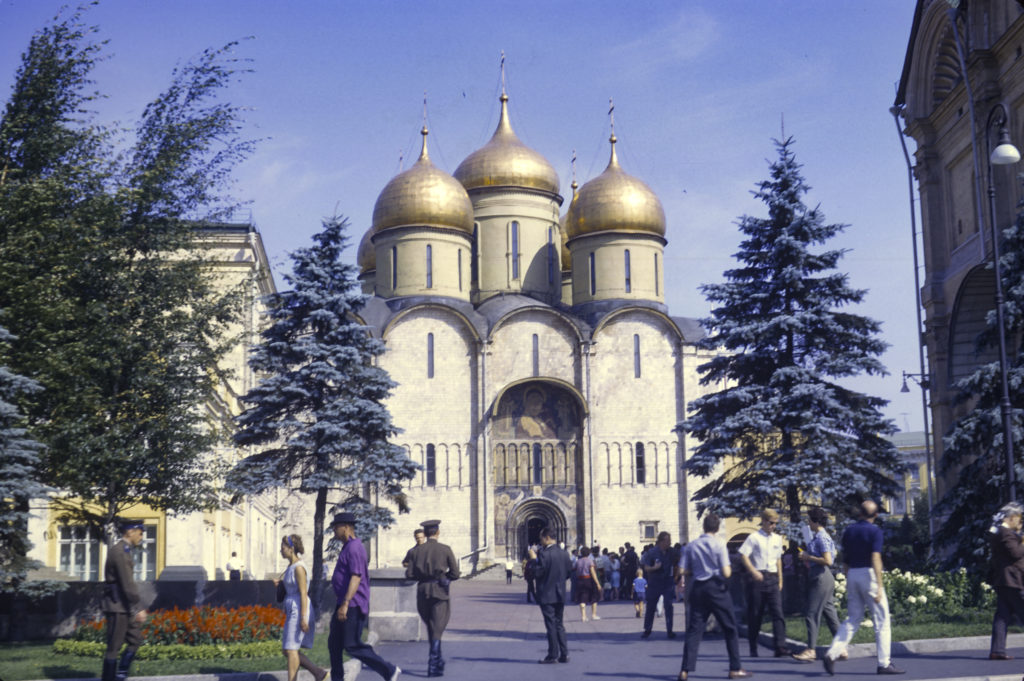
The Uspensky Sobor, or Cathedral of the Dormition, completed in 1479, was the work of an Italian architect, and combined Russian with Renaissance traditions. All the coronations of Russian monarchs from 1547 to 1896 were held here, as were the installations of metropolitans and patriarchs of the Russian Orthodox Church, who are also buried here.
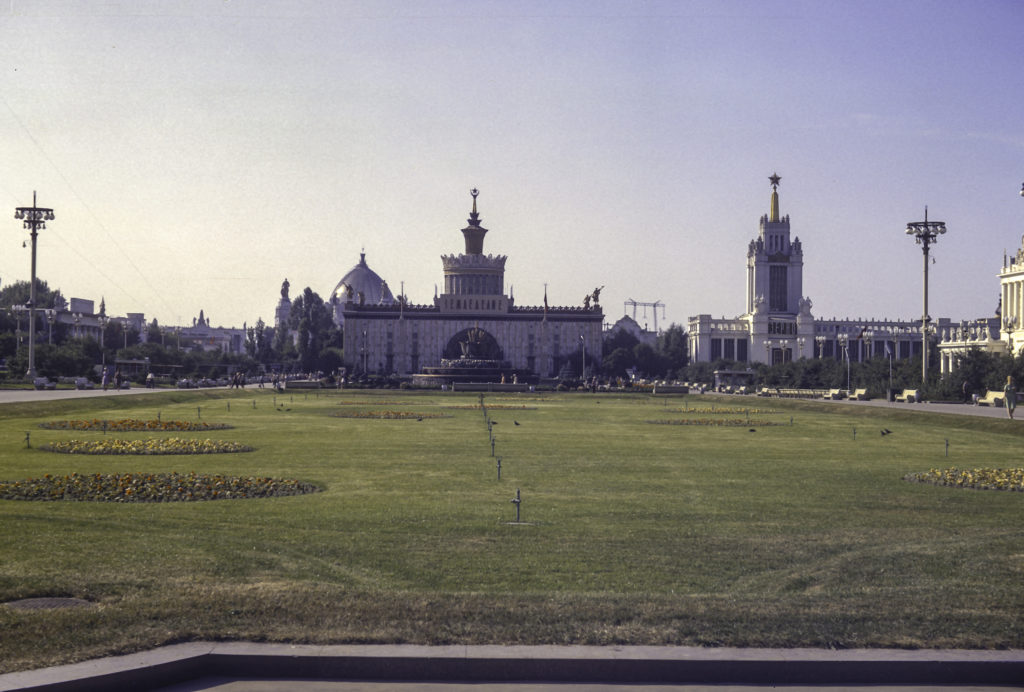
Our tour of Moscow included a visit to the Exhibition of Achievements of the National Economy (the initials in Russian are VDNKh), a permanent trade show and amusement park serving as a showcase for Soviet industry and agriculture. It was somewhat like a world’s fair (I had visited the New York World’s fair before leaving on the Munich summer school trip). It had pavilions devoted to each Soviet republic, such as the Ukraine (whose pavilion appears in the center of the picture above), Armenia, Kyrgyzstan, etc., and to regions of the Russian Republic, such as the North Caucasus, as well as pavilions devoted to specific fields or industries, such as Space, Atomic Energy, Engineering, Electronics, Education, etc.
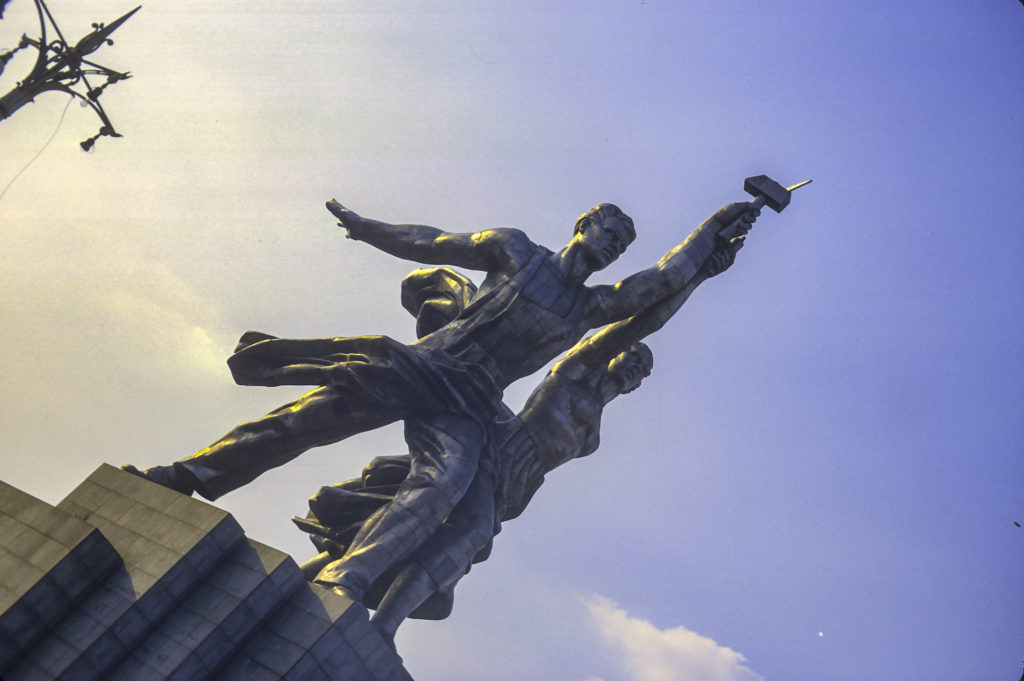
The most striking structure at the VDNKh was the 25-meter (78 feet) stainless-steel Statue of Worker and Collective Farm Woman, originally designed for an exhibition in Paris in 1937. It is a gigantic statue in Socialist Realism style, depicting a worker and a peasant woman holding a hammer and sickle together pointing at the sky – in other words, something as unrealistic as could possibly be imagined. The designer, a woman named Vera Mukhina, won a Stalin Prize for it. If there were an award for the most banal statue in the world, this would surely be the hands-down winner by popular acclaim. I cannot recall every having met anyone, even any Russian (except for our guides, who had to toe the party line), who felt otherwise. Yet to this day it stands at the Exhibition, which has undergone many changes in the years since I visited it.
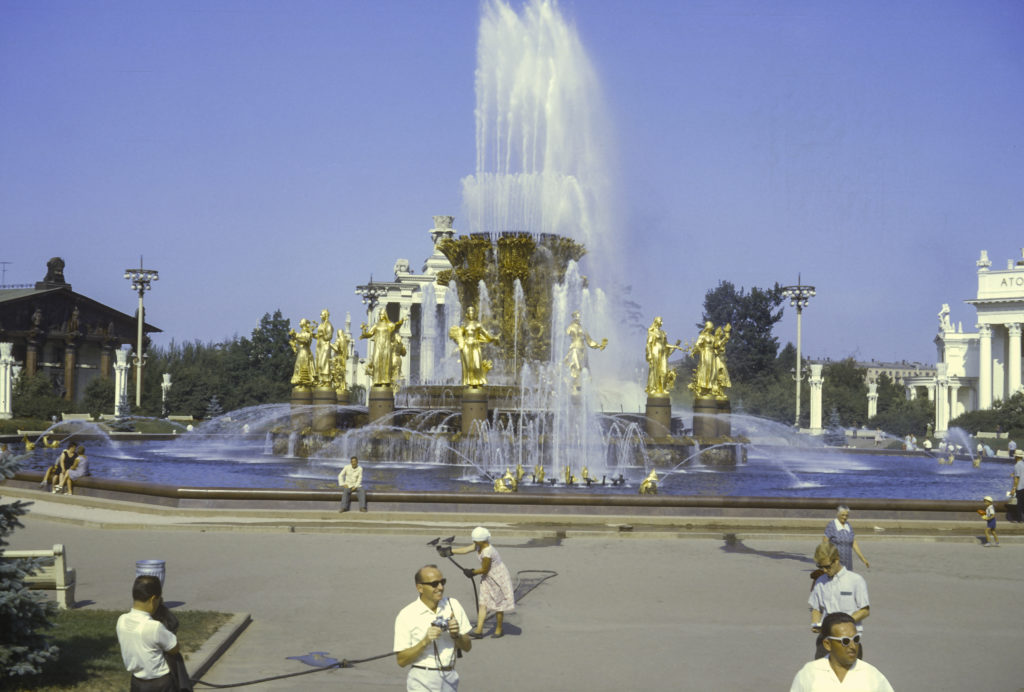
Much more attractive than the stainless-steel statue was the Fountain of the Friendship of Nations, pictured above.
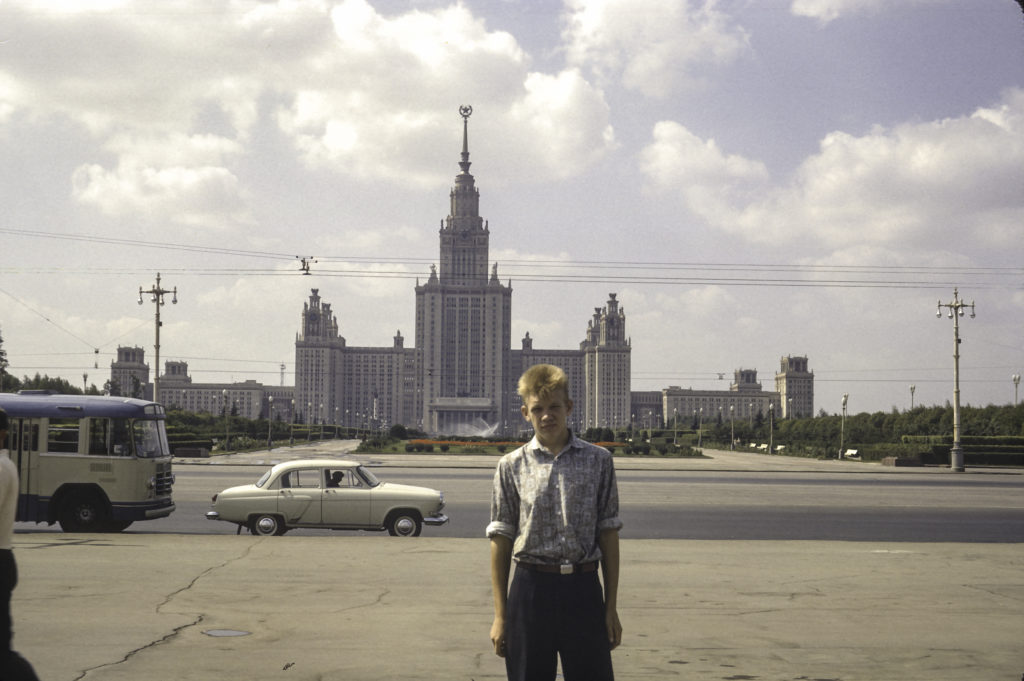
Moscow State University, or, to use its full title, the M. V. Lomonosov Moscow State University, was founded in 1755, during the reign of Empress Elizabeth, the daughter of Peter the Great. Lomonosov was Russia’s first great scientist and is often called Russia’s Ben Franklin, of whom he was a contemporary. He is credited with important scientific discoveries and sometimes is cited as the inventor of the light bulb, over a century before Edison. He also played a key role in the founding of Moscow University. The university is usually referred to by its initials in Russian, MGU. The circumstances of my initial visit to MGU in 1964 are worth relating. I had brought a couple cartons of cigarettes with me on the trip, even though I never smoked them myself, because I had been told that offering people a cigarette was a good way to initiate contacts with people in Europe and the USSR. This, of course, was not in the interest of the Soviet regime, who were interested in tourism as a means of spreading propaganda and obtaining hard currency, but not at all in promoting unsupervised acquaintences between Soviet citizens and foreigners. Our guides accused me of wanting to sell cigarettes for profit and confiscated the cartons I had brought, but later, about the time of our visit to MGU, they returned the cigarettes, and I was able to use them there. At that time my Russian was very rudimentary – I hadn’t learned much either in two years of college classes or the Munich summer school – but I found I was able to exchange cigarettes for znachki – little pins with Soviet motifs, such as red stars or images of Lenin – which made great souvenirs (I still have some of them). There were a number of locals hanging out near the university, and I managed to snag a few znachki there, and one of the kids there even let me shoot his picture with the main MGU building as the background.
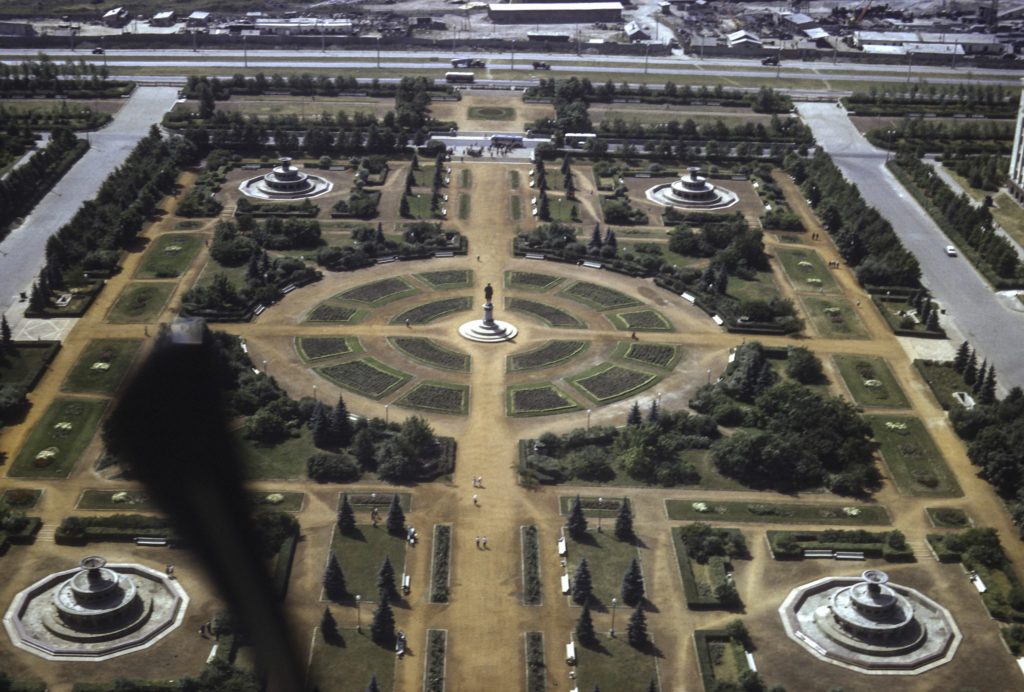
The main building of MGU is located in an area formerly called Sparrow Hills, later renamed Lenin Hills, five kilometers from the center of Moscow. The central tower is 240 meters (787 feet) tall, with 36 stories, and at the time of its construction in 1953 was the tallest building in Europe and the tallest in the world outside New York. Our guides took us up to the top floor, and we were able to take pictures of the city from there, despite a Soviet rule against taking pictures from tall buildings, which even our guides cited and then disregarded. Unfortunately, I somehow contrived to get part of the left earpiece of my sunglasses in the field of a couple of my pictures, such as the one above, which shows the immediate grounds of MGU looking east, with a statue of Lomonosov in the center.
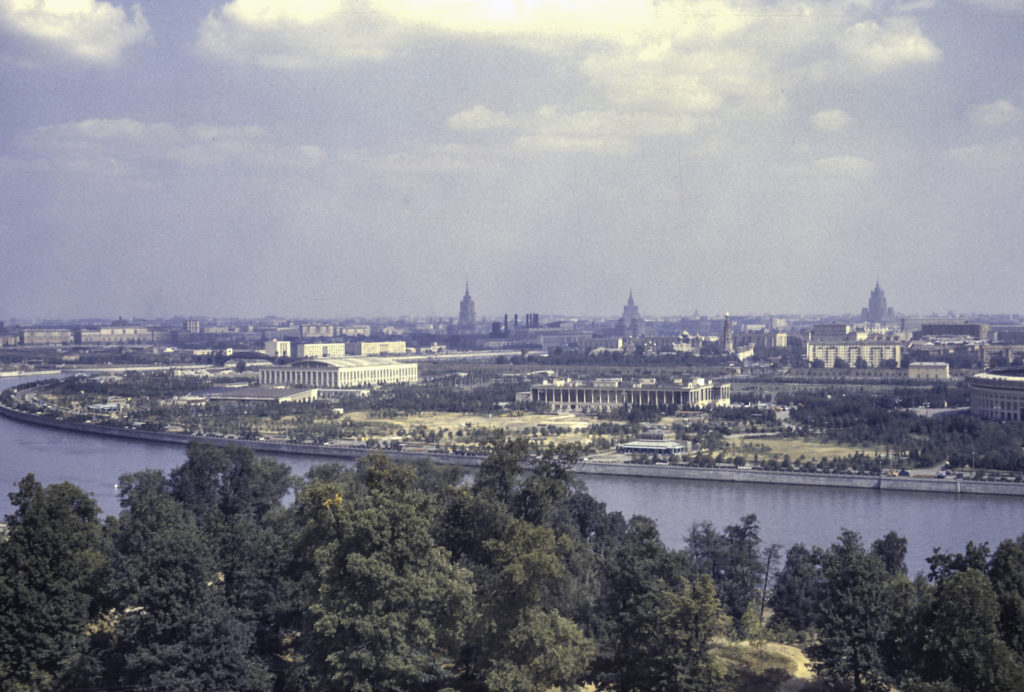
It was a mostly clear day and the view from the top floor of MGU was great. I attempted to shoot a panorama, starting on the left (northeast) and ending on the southeast. The three tall buildings in the picture, jutting above the rest of the city skyline, from left to right, are the Hotel Ukraine, the Kudrinskaia Square Building, and the Ministry of Foreign affairs. These, including MGU, were all part of a skyscraper construction program ordered by Joseph Stalin, who thought that Moscow needed skyscrapers to assert the moral authority of the USSR as the socialist homeland. His original vision called for nine skyscrapers, but only seven were built. In addition to the four already named, there were the Leningrad Hotel, the Red Gates administrative building, and the Kotelnicheskaia Embankment building.
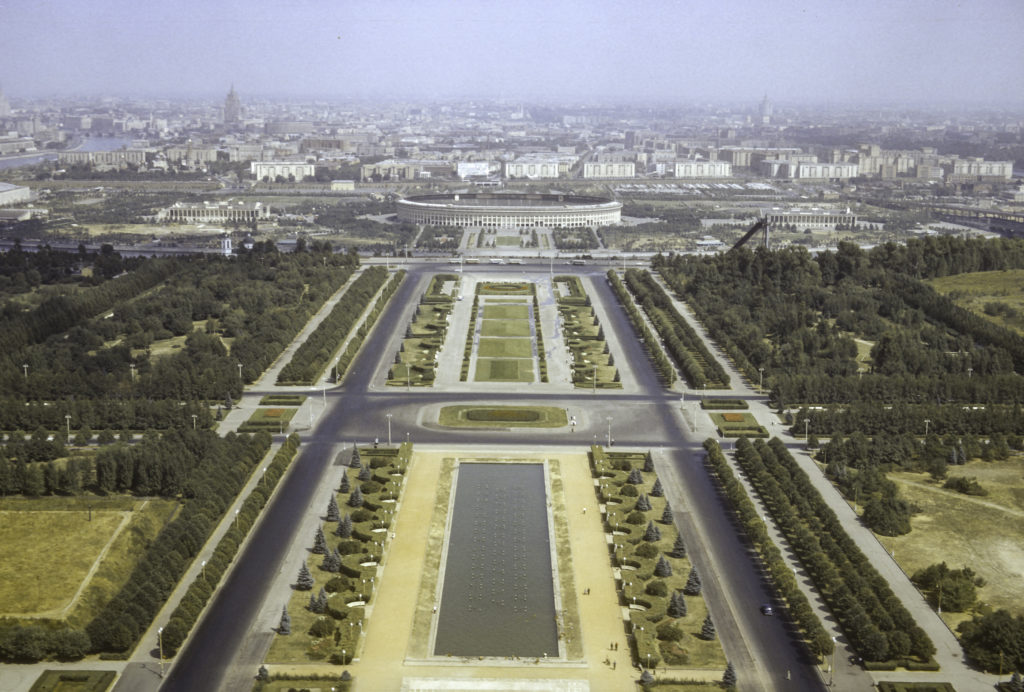
The center shot of the Moscow panorama captures the neat rectangle of University Square, stretching out to what is now Kosygin Street, just this side of Moscow River. On the other side of the river is the Luzhniki sports complex and Luzhniki Stadium, the national stadium of Russia. It was built in 1955-56 as Lenin Stadium and renamed Luzhniki Stadium in 1992. It was the main venue for the Olympic Games of 1980, for which many other buildings were constructed near it as well. It is used primarily as a football (soccer) stadium, but hosts other types of sporting events, such as motorcycle racing on the ice in winter. It was demolished and rebuilt in 2013-2017 with an increased seating capacity (from 78,000 to 81,000).
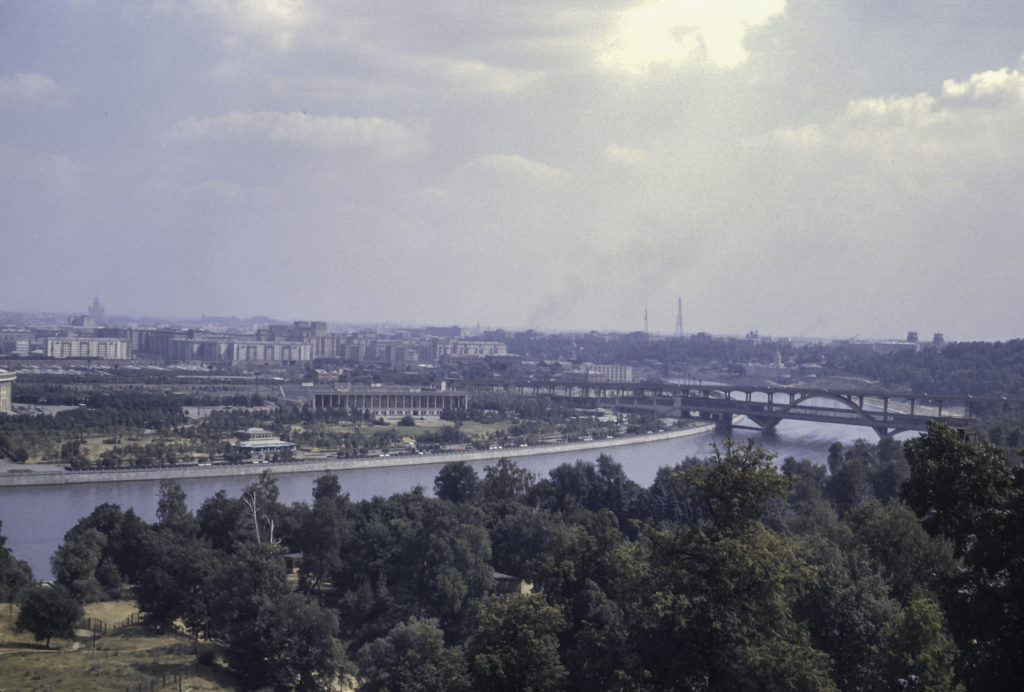
The third or right-most shot of the panorama series looks southeast, across the Moscow River. The edge of Luzhniki Stadium is on the left; the large structure just to the left of center is the Luzhniki Underwater World Aqua Club – that’s a literal translation of the name; it is more commonly known in English as the Luzhniki Aqua Complex. The Luzniki Metro Bridge is on the right.
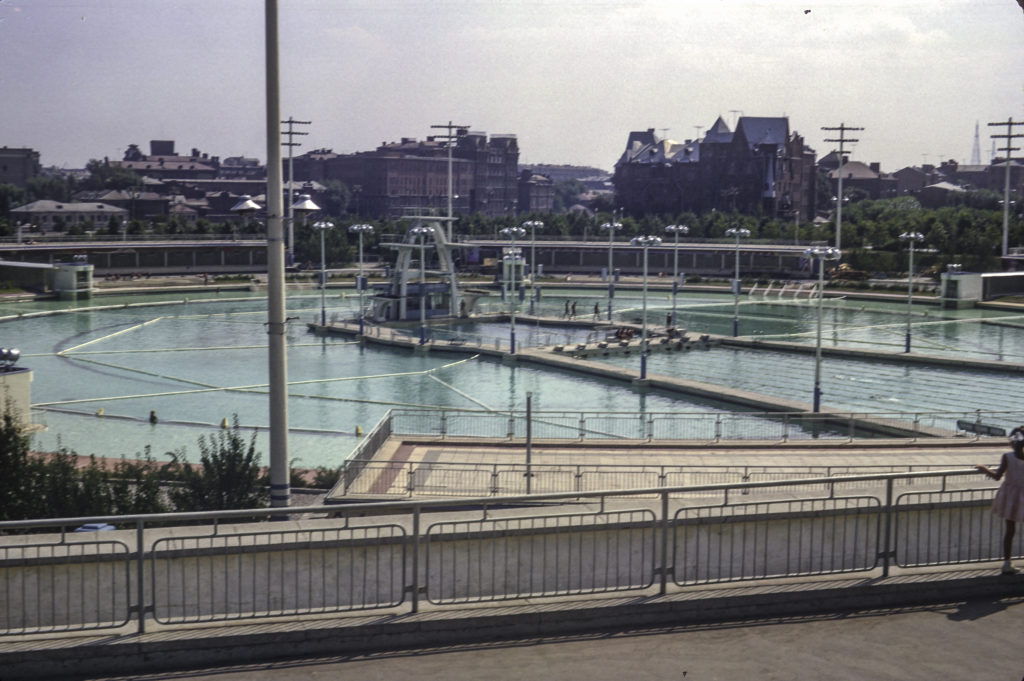
During our stay in Moscow, we went for a swim in the Moscow Swimming Pool, the largest open-air swimming pool in the world. The dressing rooms were staffed by babushki – old ladies. Russians told us to be circumspect about undressing there because “even though they are old women, they are still women.” The story behind the origins and ultimate fate of this site is worth telling. I first heard it from a Jewish friend whom I was trying to help to get out of the Soviet Union in 1972.
After the War of 1812, Alexander I determined to build a new cathedral in Moscow in honor of Christ the Savior, to express the gratitude of all Russia for its deliverance from Napoleon. However, construction only began in earnest under Alexander’s successor, Nicholas I, in 1839, and the cathedral was not completed until 1882. When completed, it was 103 meters (338 feet) tall and had domes gilded with 20 tons of gold. The interior featured 11,000 square feet of marble plaques listing battles, commanders, units, casualties and awards of the Napoleonic wars.
In 1931 the cathedral was dynamited into rubble. Joseph Stalin had selected the site for the building of a skyscraper to serve as a monument to Lenin and a showcase of socialism, called the Palace of Soviets. (Another motive for demolition was to get hold of the gold in the domes, which was needed to help finance the industrialization programs.) It was projected to be the tallest building in the world at 415 meters (1362 feet), and was to be crowned with a 100-meter (328 feet) statue of Lenin weighing 6,000 tons. Construction on this monstrosity actually began in 1937, but was interrupted by World War II and never resumed. Construction of the 129.5-meter (425 feet) diameter swimming pool began in 1958 and was completed in 1960.
The demolition of the cathedral was one of the more notorious esthetic transgressions of the Stalin era. Even non-Christians were scandalized by it. After the collapse of the Soviet Union, the cathedral was rebuilt with the aid of donations from millions of Russian citizens, and the newly rebuilt cathedral was consecrated on August 19, 2000.
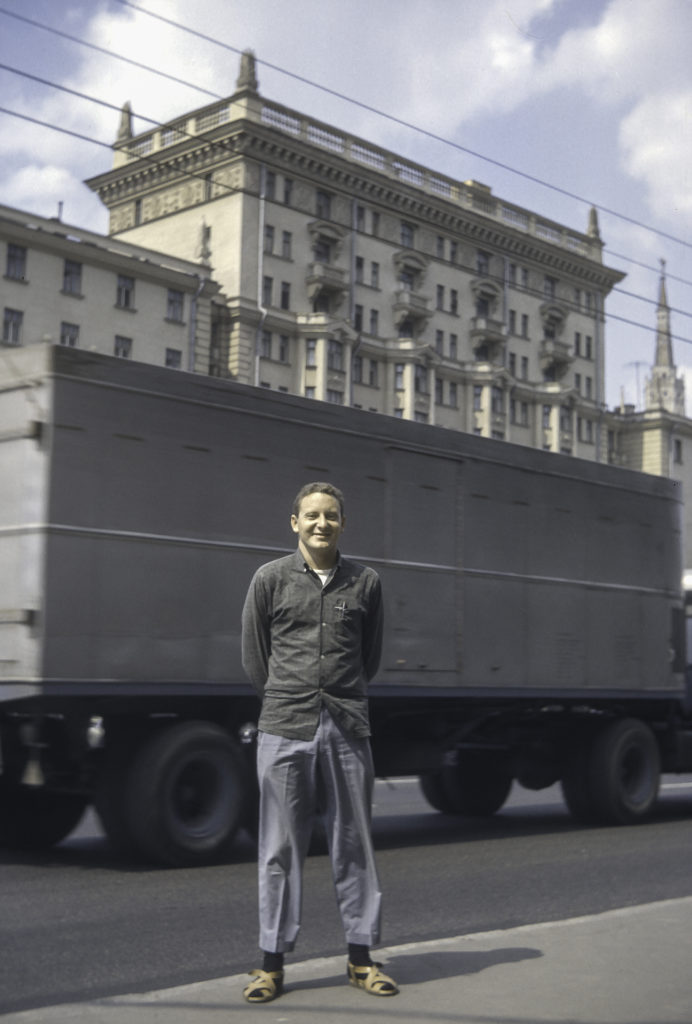
One day we visited the American Embassy, on Chaikovsky Street, where I had a friend take a picture of me across the street in front. I didn’t notice, and apparently neither did the picture-taker, that as the photo was being shot a large truck zoomed by in back of me, obscuring the lower floors of the Embassy.